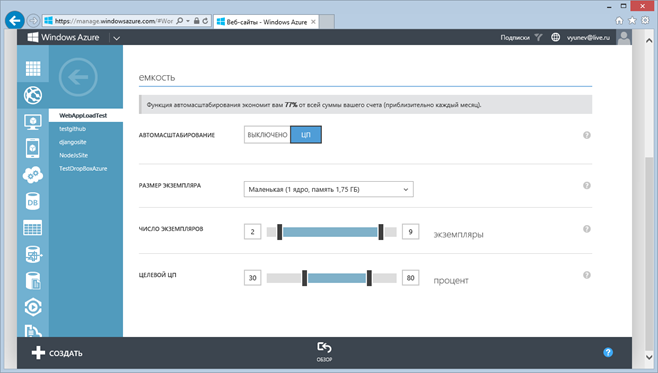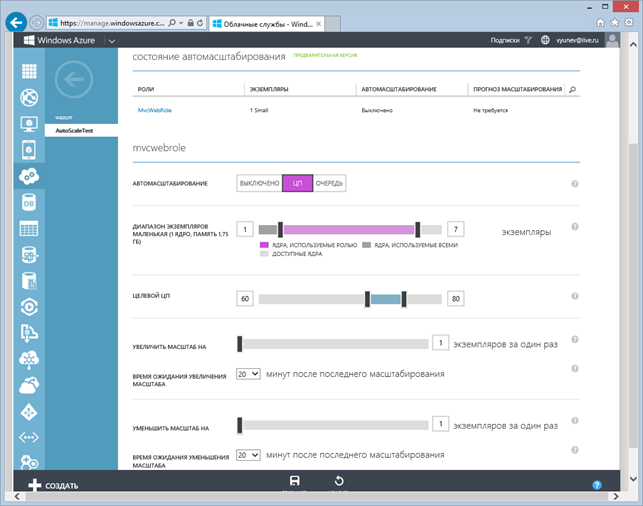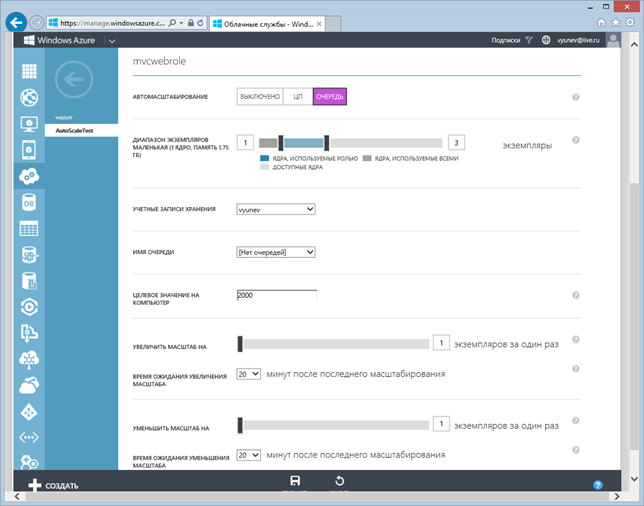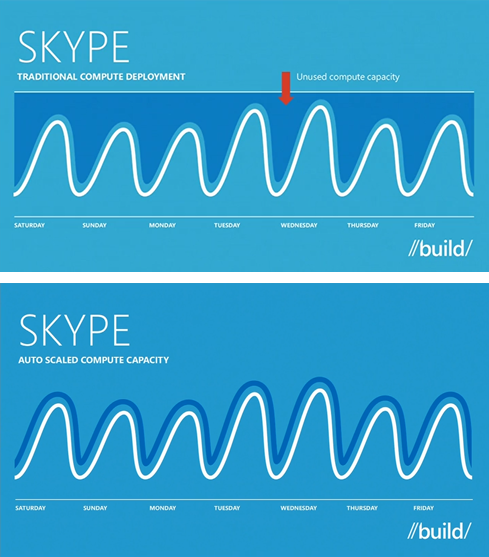Automatic scaling of websites, cloud services and virtual machines
In this article we will talk about the announcement of the new service of automatic scaling of websites, cloud services and virtual machines in Windows Azure .
Thanks to the auto-scaling feature, a Windows Azure user can set the rules and conditions for automatically increasing or decreasing allocated computing power based on the current load on applications.
')
The Windows Azure platform will independently increase or decrease the instances of websites, cloud services or virtual machines, depending on the specified conditions and the current load on the cloud application. Thus, users of the Windows Azure cloud platform can now use automatic scaling to quickly allocate cloud power while increasing load and saving money when the load drops.

Windows Azure Web Sites cloud-based auto scaling is available based on CPU load setting. The user of Windows Azure Web Sites for the purposes of scaling should choose the size of each instance of the website: small, medium and large. The sizes differ by the number of CPU cores and the amount of available memory.
Using the administration panel, the user can set scaling targets — the minimum and maximum CPU load limits at which configuration changes occur, web site instances are allocated or deleted.
For example, if you set the minimum redistribution of scaling targets to 30% and the maximum limit to 80%, Windows Azure will allocate new instances of websites (and automatically balance the load between them) while the average load on the CPU is at more than 80%. At the same time, Windows Azure will gradually remove instances if the average CPU load is kept at less than 30%.
A Windows Azure user can specify one more parameter — limits on the maximum and minimum number of selected instances of websites. By setting these limits, the user hard-sets the minimum and maximum number of web site instances that can be allocated to Windows Azure.
For example, if you set the "Number of instances" parameter in the range from 2 to 9, then under any conditions, Windows Azure will scale the website from two instances to nine and not a single instance anymore.
Another useful feature available in the administration panel for the auto-scaling service is the function of estimating monthly savings based on current settings. The user of Windows Azure will always be aware of the preliminary assessment of the savings that he receives through the automatic scaling of their websites.

Windows Azure cloud services can be automatically scalable based on CPU utilization in the same way as websites. However, additional functions and scaling options are available for cloud services.
In the Windows Azure Cloud Services Administration Panel, a scaling prediction is available to the user, which announces the need to perform an early scaling for the cloud service.
Cloud services, unlike websites, can scale to multiple instances at once. A special option is available in the administration panel that allows you to specify the number of instances to increase and decrease the scale of the service.
In addition, to configure the automatic scaling of the cloud service, you must specify a waiting period after each zoom change. The user can specify a wait time in minutes before the next zoom in or out. It makes sense for scenarios where new instances of roles rise with a delay and are not immediately ready to unload the service load.

The biggest difference in the automatic scaling of cloud services from websites is the support for scaling based on the number of messages in the queue.
This auto scaling mode allows you to increase or decrease the number of cloud service instances based on the current number of messages in the message queue in the Windows Azure storage. Thanks to this feature, Windows Azure users can create message queue services that automatically scale when the number of messages in the queue grows significantly or drops noticeably.
In the administration panel, the user can specify the storage account containing the message queue and the name of the queue itself, based on the number of messages in which the service needs to be scaled. In addition, the user must specify the number of messages in the queue at which Windows Azure will automatically increase or decrease the number of instances of the service.
Automatic scaling of virtual machines in Windows Azure is based on the cloud service associated with the machines.
The virtual machine instances involved in scaling should be combined with one set of availability. As you zoom in, the virtual machines will turn on, and when they decrease, they stop.
The remaining scaling functions are identical to those in cloud services.
As part of the plenary report of the Build 2013 conference, Scott Guthrie announced the transfer of the Skype service infrastructure to the Windows Azure cloud environment.

This transfer will allow the service to abandon the permanent acquisition, deployment and maintenance of its own servers.
In addition, thanks to the auto-scaling feature, Skype will save more than 40% of funds during periods of reduced service load and automatically increase capacity during growth periods.
Do not miss the previous announcements of updates to the Windows Azure platform, which are released almost every week:
Below you will find links to resources that will help you in using the Microsoft cloud platform:
And if you are already developing on Windows Azure or want to find the developers of your service, visit appprofessionals.ru .
We will be happy to answer your questions at azurerus@microsoft.com . And we are waiting for you in the Windows Azure Community on Facebook . Here you will find experts (don't forget to ask them questions), photos, and lots and lots of news.
Video recordings of Windows Azure Summit reports and video interviews that were conducted during a large cloud conference. DevCon 2013 Windows Azure conference talks you can find here .
Auto scaling
Thanks to the auto-scaling feature, a Windows Azure user can set the rules and conditions for automatically increasing or decreasing allocated computing power based on the current load on applications.
')
The Windows Azure platform will independently increase or decrease the instances of websites, cloud services or virtual machines, depending on the specified conditions and the current load on the cloud application. Thus, users of the Windows Azure cloud platform can now use automatic scaling to quickly allocate cloud power while increasing load and saving money when the load drops.
Scaling cloud websites

Windows Azure Web Sites cloud-based auto scaling is available based on CPU load setting. The user of Windows Azure Web Sites for the purposes of scaling should choose the size of each instance of the website: small, medium and large. The sizes differ by the number of CPU cores and the amount of available memory.
Using the administration panel, the user can set scaling targets — the minimum and maximum CPU load limits at which configuration changes occur, web site instances are allocated or deleted.
For example, if you set the minimum redistribution of scaling targets to 30% and the maximum limit to 80%, Windows Azure will allocate new instances of websites (and automatically balance the load between them) while the average load on the CPU is at more than 80%. At the same time, Windows Azure will gradually remove instances if the average CPU load is kept at less than 30%.
A Windows Azure user can specify one more parameter — limits on the maximum and minimum number of selected instances of websites. By setting these limits, the user hard-sets the minimum and maximum number of web site instances that can be allocated to Windows Azure.
For example, if you set the "Number of instances" parameter in the range from 2 to 9, then under any conditions, Windows Azure will scale the website from two instances to nine and not a single instance anymore.
Another useful feature available in the administration panel for the auto-scaling service is the function of estimating monthly savings based on current settings. The user of Windows Azure will always be aware of the preliminary assessment of the savings that he receives through the automatic scaling of their websites.
CPU based cloud service scaling

Windows Azure cloud services can be automatically scalable based on CPU utilization in the same way as websites. However, additional functions and scaling options are available for cloud services.
In the Windows Azure Cloud Services Administration Panel, a scaling prediction is available to the user, which announces the need to perform an early scaling for the cloud service.
Cloud services, unlike websites, can scale to multiple instances at once. A special option is available in the administration panel that allows you to specify the number of instances to increase and decrease the scale of the service.
In addition, to configure the automatic scaling of the cloud service, you must specify a waiting period after each zoom change. The user can specify a wait time in minutes before the next zoom in or out. It makes sense for scenarios where new instances of roles rise with a delay and are not immediately ready to unload the service load.
Scaling of cloud services based on queued messages

The biggest difference in the automatic scaling of cloud services from websites is the support for scaling based on the number of messages in the queue.
This auto scaling mode allows you to increase or decrease the number of cloud service instances based on the current number of messages in the message queue in the Windows Azure storage. Thanks to this feature, Windows Azure users can create message queue services that automatically scale when the number of messages in the queue grows significantly or drops noticeably.
In the administration panel, the user can specify the storage account containing the message queue and the name of the queue itself, based on the number of messages in which the service needs to be scaled. In addition, the user must specify the number of messages in the queue at which Windows Azure will automatically increase or decrease the number of instances of the service.
Virtual machine scaling
Automatic scaling of virtual machines in Windows Azure is based on the cloud service associated with the machines.
The virtual machine instances involved in scaling should be combined with one set of availability. As you zoom in, the virtual machines will turn on, and when they decrease, they stop.
The remaining scaling functions are identical to those in cloud services.
Success Story: Skype
As part of the plenary report of the Build 2013 conference, Scott Guthrie announced the transfer of the Skype service infrastructure to the Windows Azure cloud environment.

This transfer will allow the service to abandon the permanent acquisition, deployment and maintenance of its own servers.
In addition, thanks to the auto-scaling feature, Skype will save more than 40% of funds during periods of reduced service load and automatically increase capacity during growth periods.
Do not miss
Do not miss the previous announcements of updates to the Windows Azure platform, which are released almost every week:
- Announcements and commercial availability of Windows Azure Web Sites;
- Availability of Windows Server 2012 R2, SQL Server 2014 and Visual Studio 2013 Ultimate in the image gallery of Windows Azure virtual machines
- Cloud backend as a service for Windows, iOS, Windows Phone, Android and mobile HTML5 applications
- and others on the blog ...
useful links
Below you will find links to resources that will help you in using the Microsoft cloud platform:
- Free 30-day trial of Windows Azure;
- Free access to Windows Azure resources for startups , partners , teachers, MSDN subscribers ;
- Windows Azure Development Center (azurehub.ru) - scripts, tutorials, examples, recommendations on the choice of services and development on Windows Azure;
- News channel Windows Azure TV in Russian on YouTube;
- Latest Windows Azure News - Twitter.com/windowsazure_ru ;
- http://wazurr.ru - content aggregator for Windows Azure in Russian and English.
And if you are already developing on Windows Azure or want to find the developers of your service, visit appprofessionals.ru .
We will be happy to answer your questions at azurerus@microsoft.com . And we are waiting for you in the Windows Azure Community on Facebook . Here you will find experts (don't forget to ask them questions), photos, and lots and lots of news.
Video recordings of Windows Azure Summit reports and video interviews that were conducted during a large cloud conference. DevCon 2013 Windows Azure conference talks you can find here .
Source: https://habr.com/ru/post/185926/
All Articles